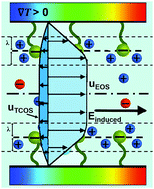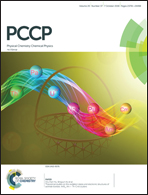Highly enhanced liquid flows via thermoosmotic effects in soft and charged nanochannels
Abstract
Enhancing nanoscale liquid flows remains an existing challenge in nanofluidics. Here we propose the generation of highly augmented thermoosmotic (TOS) liquid flows in soft nanochannels (or nanochannels functionalized by grafting with end-charged polyelectrolyte or PE brushes) by employing an axial temperature gradient. The TOS transport is a combination of the induced-electric-field electroosmotic (EOS) transport and a thermo-chemioosmotic (TCOS) transport with the latter resulting from an induced pressure gradient on account of the changes associated with the imposition of the axial temperature gradient. The end-charged brushes develop an electric double layer (EDL) localized at the charged, non-grafted brush end. Depending on the system parameters, this EDL localization massively augments the influence of the EOS body force and the induced pressure-gradient resulting in a TOS transport in soft nanochannels that can be more than one order of magnitude larger than that in brush-free nanochannels. Given the existing notion that the presence of the brushes invariably reduces the flow strength, this result of massive flow augmentation is extremely significant and non-trivial serving as a paradigm shift in the study of liquid transport in brush-grafted nanochannels.



 Please wait while we load your content...
Please wait while we load your content...